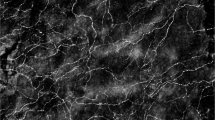Summary
The number and caliber of myelinated and non-myelinated fibers of entire and sensory vagal nerves of cats were studied by means of light and electron microscopy. The results obtained with electron microscopy show that the non-myelinated component is particularly rich (about 40,000 elements at the cervical level), with clearly higher numbers of fibers than demonstrated thus far with light microscopy. The ratio of myelinated to non-myelinated fibers is on the average 1∶ 4 for the total vagi and only 1∶ 8 for the sensory vagal component. The comparison of the nerve above and below the level of the nodose ganglion shows that (1) mean fiber diameter is usually greater at the infranodose than at the supranodose level, and (2) some myelinated fibers of small diameter occurring below the nodose ganglion become non-myelinated above it. Additionally, the number of non-myelinated fibers per Schwann cell is greater at the supranodose than at the infranodose level; this speaks in favor of a reorganization of the C-fiber population from one level to the other.
Similar content being viewed by others
References
Agostoni E, Chinnock JE, Daly M de B, Murray JG (1957) Functional and histological studies on the vagus nerve and its branches to the heart, lungs and abdominal viscera in the cat. J Physiol Lond 135:182–205
Cajal SR (1909) Histologie de système nerveux de l'Homme et des Vertébrés. Maloine Edt Paris, 986 pp
Dubois FS, Foley JO (1937) Quantitative studies of the vagus nerve in the cat. II. The ratio of jugular to nodose fibres. J Comp Neurol 67:69–87
Duclaux R, Mei N, Ranieri F (1976) Conduction velocity along the afferent vagal dendrite: a new type of fibre. J Physiol Lond 260:480–495
El Ouazzani T, Mei N (1979) Mise en évidence électrophysiologique des thermorécepteurs vagaux dans la région gastro-intestinale. Leur rôle dans la régulation de la motricité digestive. Exp Brain Res 34:419–434
Evans DHL, Murray JG (1954) Histological and functional studies on the fibre composition of the vagus nerve of the rabbit. J Anat 88:320–337
Foley JO, Dubois FS (1937) Quantitative studies of the vagus nerve in the cat. I. The ratio of sensory to motor fibres. J Comp Neurol 67:49–64
Gabella G, Pease HL (1973) Number of axons in the abdominal vagus of the rat. Brain Res 58:465–469
Iggo A (1957) Gastric mucosal chemoreceptors with vagal afferent fibres in the cat. Quart J Exp Physiol 42:398–409
Jammes Y, Mei N (1979) Assessment of the pulmonary origin of the bronchoconstrictor vagal tone. J Physiol Lond 291:305–316
Jones RL (1937) Cell fiber ratios in the vagus nerve. J Comp Neurol 67:469–482
Kemp DR (1973) A histological and functional study of the gastric mucosal innervation in the dog. Part I: The quantification of the fibre content of the normal supradiaphragmatic vagal trunks and their abdominal branches. Austr N Z J Surg 43:288–294
Leek BF (1972) Abdominal visceral receptors. In: Neu E (ed) Handbook of sensory physiology. Vol III/1 Enteroceptors Springer Verlag, pp 113–160
Leek BF (1977) Abdominal and pelvic visceral receptors. Br Med Bull 33:163–168
Mei N (1966) Existence d'une séparation anatomique des fibres vagales efférentes et afférentes au niveau du ganglion plexiforme du Chat. Etude morphologique et électrophysiologique. J Physiol Paris 58:253–254
Mei N (1970a) Disposition anatomique et propriétés électrophysiologiques des neurones sensitifs vagaux chez le Chat. Exp Brain Res 11:465–479
Mei N (1970b) Mécanorécepteurs vagaux digestifs chez le Chat. Exp Brain Res 11:502–514
Mei N, Dussardier M (1966) Etude des lésions pulmonaires produites par la section des fibres sensitives vagales. J Physiol Paris 58:427–431
Mei N, Boyer A, Condamin M (1971) Etude comparée des deux prolongements de la cellule sensitive vagale. CR Soc Biol 165:2371–2374
Ochoa J, Main WGP (1969) The normal sural nerve in man. L Ultrastructure and numbers of fibres and cells. Acta Neuropathol (Berl) 13:197
Paintal AS (1963) Vagal afferent fibres. Ergeb Physiol 52:74–116
Paintal AS (1973) Vagal sensory receptors and their reflex effects. Physiol Rev 53:159–226
Paintal AS (1977) Thoracic receptors connected with sensation. Br Med Bull 33:169–174
Stacey MJ (1969) Free nerve endings in skeletal muscle of cat. J Anat 105:231–254
Serratrice G, Mei N, Pellissier JF, Cros D (1978) Cutaneous, muscular and visceral unmyelinated fibres: comparative study. In: Elsevier (ed) International Symposium on peripheral neuropathies. Milan
Author information
Authors and Affiliations
Rights and permissions
About this article
Cite this article
Mei, N., Condamin, M. & Boyer, A. The composition of the vagus nerve of the cat. Cell Tissue Res. 209, 423–431 (1980). https://doi.org/10.1007/BF00234756
Accepted:
Issue Date:
DOI: https://doi.org/10.1007/BF00234756



